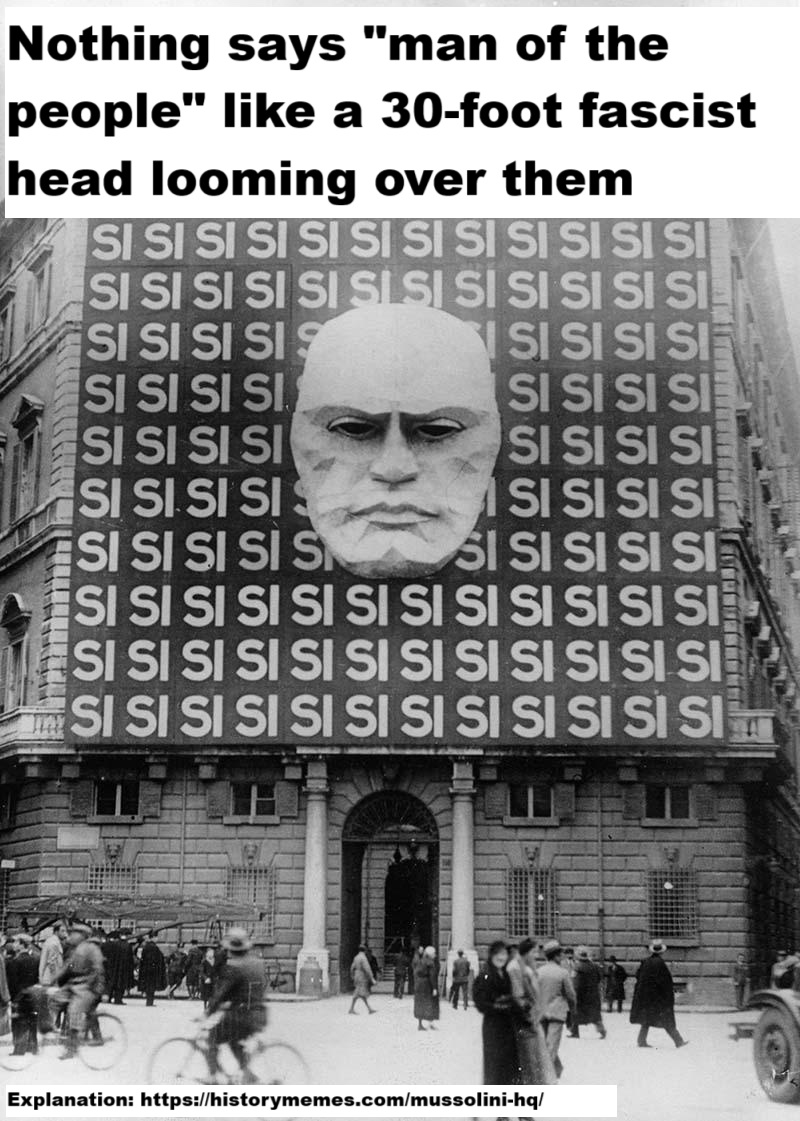
- The massive sculpted face represents Mussolini himself, and the repeated word “SI” (“yes” in Italian) was a piece of propaganda encouraging public approval of the Fascist regime, during the 1934 Italian general election, where Mussolini’s National Fascist Party (PNF) was the only party legally permitted to stand.
- The imposing design and stark repetition reflect Fascism’s obsession with spectacle, authority, and visual domination, turning architecture and propaganda into instruments of psychological control.
However Mussolini, who was the son of blacksmith, liked to play up his his humble origins and portrayed himself as a “man of the people.”
Mussolini’s Rise to Power (1922–1925)
- Post–World War I Italy was politically fragmented, economically unstable, and socially volatile. Many Italians felt betrayed by the peace settlement and disillusioned with liberal democracy.
- Mussolini, a former socialist journalist, founded the Fasci di Combattimento in 1919, promoting nationalism, anti-communism, and a cult of strength and unity.
- By exploiting chaos and fear of left-wing revolution, Mussolini built the Blackshirts (paramilitary squads) who used violence to suppress opposition.
- In October 1922, Mussolini staged the March on Rome, a show of force that pressured King Victor Emmanuel III to appoint him Prime Minister.
- Between 1922 and 1925, Mussolini dismantled democratic institutions, censored the press, outlawed opposition parties, and declared himself Il Duce (“The Leader”), marking the full establishment of the Fascist dictatorship.
Fascist Italy (1925–1943/45)
- The regime glorified the state, war, and the leader, promoting slogans like “Believe, Obey, Fight.”
- Mussolini sought to build a totalitarian state, controlling education, culture, and even leisure through organizations like the Opera Nazionale Dopolavoro.
- Architecture and public imagery (like the one in your photo) were used to project power and permanence, linking modern Italy to the grandeur of the ancient Roman Empire.
- Foreign policy aimed to create a new Roman Empire: Italy invaded Ethiopia in 1935, intervened in Spain (1936), and aligned with Nazi Germany under the Pact of Steel (1939).
- During World War II, Mussolini’s Italy performed poorly militarily, and by 1943, the regime collapsed after Allied invasion and internal dissent.
- This lead to the short lived Italian Social Republic (1943-45), with Mussolini again as its head after being freed by the Germans in Operation Eiche.
- Mussolini was finally captured and executed by Italian partisans in April 1945.
Legacy and Aftermath (Post-1945 to Today)
- After World War II, Italy became a republic (1946) and banned the Fascist Party.
- Yet, Mussolini’s legacy remains controversial:
- Some Italians recall him as a symbol of national strength and modernization.
- Most historians emphasize his authoritarianism, censorship, militarism, and catastrophic alliance with Hitler.
- Neo-fascist and far-right movements occasionally invoke Mussolini’s image or slogans, especially in times of political polarization.
- The visual language of Fascism, bold architecture, propaganda imagery, and leader worship, continues to influence discussions of political branding and mass psychology.
For more about Mussolini’s and Italian Fascism see the following books:
Leave a Reply